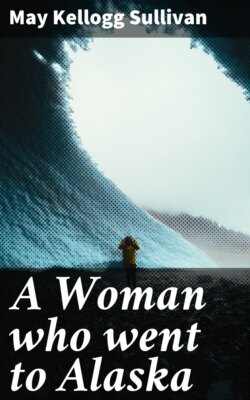Читать книгу A Woman who went to Alaska - May Kellogg Sullivan - Страница 11
На сайте Литреса книга снята с продажи.
ОглавлениеGOING TO DAWSON IN WINTER.
Now in Dawson I called upon Carrie N. eighteen months later, and heard her tell the story of her trip to the Klondyke. They had landed, she said, at Dyea from the "Alki" with their many tons of provisions and supplies, all of which had to be dumped upon the beach where no dock or wharf had ever been constructed. Here with dog-teams and sleds, a few horses and men "packers," their supplies were hauled up the mountain as far as "Sheep Camp," some ten miles up the mountain side. It was early springtime and the snow lay deep upon the mountains and in the gorges, which, in the vicinity of Chilkoot Pass at the summit of the mountain are frightfully high and precipitous.
The weather was not cold, and the moving of this large party of forty persons with their entire outfit was progressing as favorably as could be expected. A camp had been made at Dyea as the base of operations; another was made at Sheep Camp. At each place the women of the party did the cooking in tents while men gathered wood, built fires, and brought water. Other men worked steadily at the hauling, and most of their supplies had already been transported to the upper camp; when there occurred a tragedy so frightful as to make itself a part of never-to-be-forgotten Alaskan history.
It was on Sunday, and a snow storm was raging, but the weather was warm. Hundreds of people thronged the trails both going up and coming down the mountain in their effort to quickly transport their outfits over to the other side, and thus make the best possible time in reaching the gold fields. Here a difference of opinion arose among the people of our Seattle party, for some, more daring than the others, wished to push on over the summit regardless of the storm; while the more cautious ones demurred and held back, thinking it the part of discretion to wait for better weather. A few venturesome ones kept to their purpose and started on ahead, promising to meet the laggards at Lake Bennett with boats of their own making in which to journey down the river and lakes to Dawson.
Their promises were never fulfilled.
While they, in company with hundreds of others as venturesome, trudged heavily up the narrow trail, a roar as of an earthquake suddenly sounded their death-knell. Swiftly down the mountain side above them tore the terrible avalanche, a monster formation of ice, snow and rock, the latter loosened and ground off the face of old Chilkoot by the rushing force of the moving snowslide urged on by a mighty wind. In an instant's time a hundred men and women were brushed, like flies from a ceiling, off the face of the mountain into their death below, leaving a space cleared of all to the bare earth where only a few seconds before had stood the patient toilers on the trail.
Only one thing remained for the living to do, and that was to drop all else and rescue, if possible, the dying and engulfed ones. This they did. When the wind had died away the snow in the air cleared, and hundreds of men threw themselves into the rescue work. Many were injured but lived. Some were buried in snow but found their way to light again. One man was entirely covered except one arm which he used energetically to inform those above him of his whereabouts. He was taken out unharmed, and lived to welcome the writer of this to Dawson, where he carted and delivered her trunk faithfully.
But Carrie N. had remained at Sheep Camp and was safe. Then her experience in nursing stood her in good stead; and while men brought the dead to camp, she, with others, for hours performed the services which made the bodies ready for burial. It was a heart-rending undertaking and required a cool head and steady hand, both of which Carrie N. possessed. Two men of her party thus lost their lives, and it was not until days afterward that the last of the poor unfortunates were found. Nearly one hundred lives were lost in this terrible disaster, but there were undoubtedly those whose bodies were never found, and whose death still remains a mystery.
